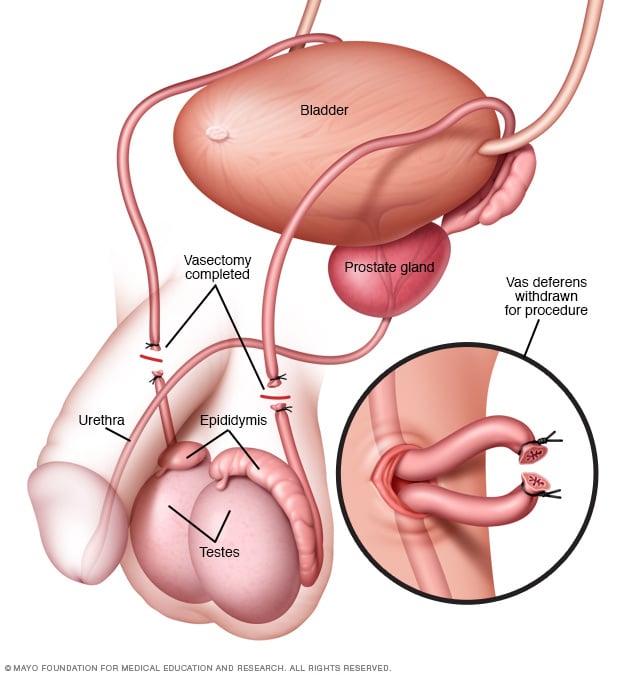Vasectomy
Overview
Vasectomy is a form of male birth control that cuts the supply of sperm to your semen. It's done by cutting and sealing the tubes that carry sperm. Vasectomy has a low risk of problems and can usually be performed in an outpatient setting under local anesthesia.
Before getting a vasectomy you need to be certain you don't want to father a child in the future. Although vasectomy reversals are possible, vasectomy should be considered a permanent form of male birth control.
Vasectomy offers no protection from sexually transmitted infections.
Why it's done
Vasectomy is a safe and effective birth control choice for men who are certain they don't want to father a child in the future.
- Vasectomy is nearly 100 percent effective in preventing pregnancy.
- Vasectomy is an outpatient surgery with a low risk of complications or side effects.
- The cost of a vasectomy is far less than the cost of female sterilization (tubal ligation) or the long-term cost of birth control medications for women.
- A vasectomy means you won't need to take birth control steps before sex, such as putting on a condom.
Risks
A potential concern with vasectomy is that you might later change your mind about wanting to father a child. Although it might be possible to reverse your vasectomy, there's no guarantee it will work. Reversal surgery is more complicated than vasectomy, can be expensive and is ineffective in some cases.
Other techniques also are available to father a child following vasectomy, such as in vitro fertilization. However, these techniques are expensive and not always effective. Before you get a vasectomy, be certain you don't want to father a child in the future.
If you have chronic testicular pain or testicular disease, you're not a good candidate for a vasectomy. For most men, a vasectomy doesn't cause any noticeable side effects, and serious complications are rare.
Side effects right after surgery can include:
- Bleeding or a blood clot (hematoma) inside the scrotum
- Blood in your semen
- Bruising of your scrotum
- Infection of the surgery site
- Mild pain or discomfort
- Swelling
Delayed complications can include:
- Chronic pain, which can happen for 1% to 2% of people who have surgery
- Fluid buildup in the testicle, which can cause a dull ache that gets worse with ejaculation
- Inflammation caused by leaking sperm (granuloma)
- Pregnancy, in the event that your vasectomy fails, which is rare.
- An abnormal cyst (spermatocele) that develops in the small, coiled tube located on the upper testicle that collects and transports sperm (epididymis)
- A fluid-filled sac (hydrocele) surrounding a testicle that causes swelling in the scrotum
Unfounded concerns
Many men worry that a vasectomy could cause serious problems — but these fears are unfounded. For example, a vasectomy won't:
- Affect your sexual performance. A vasectomy won't affect your sex drive or your masculinity in any way other than preventing you from fathering a child. Men have even reported higher sexual satisfaction after a vasectomy.
- Permanently damage your sexual organs. There's very little risk that your testicles, penis or other parts of your reproductive system will be injured during surgery. In extremely rare cases, injury to the blood supply can lead to the loss of a testicle, but that is unlikely to happen if your surgeon is skilled.
- Increase your risk of certain cancers. Although there have been some concerns about a possible link between vasectomy and testicular or prostate cancer in the past, there's no proven link.
- Increase your risk of heart disease. As with cancer fears, there doesn't appear to be any link between vasectomy and heart problems.
- Cause severe pain. You might feel minor pain and pulling or tugging during surgery, but severe pain is rare. Likewise, after surgery you might have some pain, but for most men the pain is minor and goes away after a few days.
How you prepare
Food and medications
Your doctor will probably ask you to stop taking aspirin, nonsteroidal anti-inflammatory drugs or other blood-thinning medications several days before your surgery. These can include warfarin (Coumadin, Jantoven, others), heparin and over-the-counter pain medications such as ibuprofen (Advil, Motrin IB, others).
Clothing and personal items
Bring a pair of tightfitting underwear or an athletic supporter to wear after the procedure to support the scrotum and minimize swelling.
Other precautions
Shower or bathe on the day of the surgery. Be sure to wash your genital area thoroughly. Trim hair if necessary.
Arrange for a ride home after your surgery to avoid movement and pressure on the surgery area caused by driving.
What you can expect

Before the procedure
Before doing a vasectomy, your doctor will want to meet with you to be sure it's the right form of birth control for you.
At the initial appointment (consultative visit), be prepared to discuss:
- Your understanding that vasectomy is permanent, and that it isn't a good choice if there's any chance you might want to father a child in the future
- Whether you have children and how your partner feels about the decision, if you're in a relationship
- Other methods of birth control available to you
- What vasectomy surgery and recovery involves, and possible complications
Some family medicine or general practice doctors do vasectomies, but most are done by doctors who specialize in the male reproductive system (urologists).
A vasectomy is usually done at a doctor's office or surgery center under local anesthesia, which means you'll be awake and have medicine to numb the surgery area.
During the procedure
Vasectomy surgery usually takes about 10 to 30 minutes. To perform a vasectomy, your doctor will likely follow these steps:
- Numb the surgery area by injecting a local anesthetic into the skin of your scrotum with a small needle.
- Make a small cut (incision) in the upper part of your scrotum once the surgery area is numb. Or with the "no-scalpel" technique, make a small puncture in the scrotum instead of an incision.
- Locate the tube that carries semen from your testicle (vas deferens).
- Withdraw part of the vas deferens through the incision or puncture.
- Cut the vas deferens where it has been pulled out of the scrotum.
- Seal the vas deferens by tying it, using heat (cauterizing), surgical clips or a combination of methods. Then your doctor will return the ends of the vas deferens to the scrotum.
- Close the incision at the surgery area. Stitches or glue may be used. In some cases, the wound may be left to close on its own over time.
After the procedure
Following a vasectomy, you'll have some bruising, swelling and pain. It usually gets better within a few days. Your doctor will give you instructions for recovery. Your doctor might tell you to:
- Call right away if you have signs of infection, such as blood oozing from the surgery site; a temperature of more than 100.4 F (38 C); redness; or worsening pain or swelling.
- Support your scrotum with a bandage and tightfitting underwear for at least 48 hours after your vasectomy.
- Apply ice packs to the scrotum for the first two days.
- Limit activity after surgery. You'll need to rest for 24 hours after surgery. You can probably do light activity after two or three days, but you'll need to avoid sports, lifting and heavy work for a week or so. Overdoing it could cause pain or bleeding inside the scrotum.
- Avoid any sexual activity for a week or so. If you do ejaculate, you may feel pain or notice blood in your semen. If you have sexual intercourse, use another form of birth control until your doctor confirms that sperm are no longer present in your semen.
You will ejaculate semen (seminal fluid) after a vasectomy but it will no longer contain sperm (the reproductive cells) once you have ejaculated about 20 times. A vasectomy blocks the sperm made by the testes from reaching the semen. Instead, the body absorbs the sperm, which is harmless.
Results
A vasectomy doesn't provide immediate protection against pregnancy. Use an alternative form of birth control until your doctor confirms there are no sperm in your semen. Before having unprotected sex, you'll need to wait several months or longer and ejaculate 15 to 20 times or more to clear any sperm from your semen.
Most doctors do a follow-up semen analysis six to 12 weeks after surgery to be certain that no sperm are present. You'll need to give your doctor sperm samples to examine. To produce a sperm sample, your doctor will have you masturbate and ejaculate into a container or use a special condom without lubrication or spermicide to collect semen during intercourse. Your semen is then examined under a microscope to see whether sperm are present.
Vasectomy is an effective form of birth control, but it won't protect you or your partner from sexually transmitted infections, such as chlamydia or HIV/AIDS. For that reason, you should use other forms of protection such as condoms if you are at risk of acquiring a sexually transmitted infection — even after you have a vasectomy.



